Are you ready to embark on a rewarding gardening journey? In this comprehensive guide, we’ll delve into everything you need to know about growing summer squash plant (Cucurbita pepo) right in your own home garden. From choosing the perfect location and understanding sunlight requirements to soil conditions, pest management, and harvesting techniques, we’ve got you covered. Whether you have a sprawling backyard or a cozy balcony, these practical tips will help you cultivate healthy summer squash plants and enjoy a bountiful harvest. Let’s get started! 🌱🌿🥒
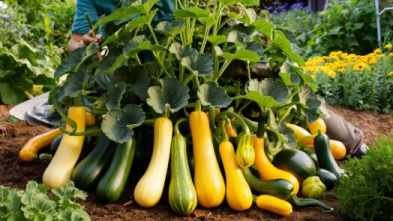
1. Location and Space
- Assess Space: Determine how much room your summer squash plant needs. These plants can spread out, so ensure they have enough space to grow comfortably.
- Vertical Gardening: Consider space-saving options like vertical gardening for summer squash. Trellises or stakes can help support the plants while maximizing your garden area1.
Information About Summer Squash Plant
- Summer squash belongs to the Cucurbit family and is known for its tender, edible skin and flesh.
- It’s an annual plant believed to have originated in Mexico and Central America.
- Summer squash is easy to grow, and just one or two plants can provide an abundance of food.
- Varieties include zucchini (dark green or yellow), crookneck (with bulbous ends), straightneck (straight narrow end), and patty pan (scalloped-edged round fruits)1.

Remember to provide full sun, keep the soil evenly moist, and use high-phosphorus fertilizer for successful summer squash cultivation. Happy gardening! 🌿🌞🌱
Are you ready to transform your garden into a vibrant haven of spicy delights? Look no further! In this comprehensive guide, we delve into the art of growing pepper plants
2. Sunlight Requirements for Summer Squash Plant
Summer squash plants have specific sunlight needs to thrive. Here’s what you need to know:
- Full Sun: Summer squash plants prefer full sun exposure. Aim for at least 6 to 8 hours of direct sunlight per day. This ensures robust growth, better fruit production, and healthier plants.
- Partial Shade: While summer squash can tolerate some shade, it’s best to avoid planting them in areas with prolonged shade. If you have limited sunlight, choose a spot that receives 4 to 6 hours of sunlight daily.
- Full Shade: Growing summer squash in full shade is not recommended. Lack of sunlight can lead to weak plants, poor fruit development, and susceptibility to diseases.
Remember to position your summer squash plants accordingly to maximize their sunlight exposure and yield. Happy gardening! 🌞🌱🌿
3. Soil Conditions for Summer Squash
Summer squash thrives in well-drained, fertile soil. Here are the key points regarding soil conditions:
- Soil Type: Ideal soil for summer squash is loamy, which is a balanced mixture of sand, silt, and clay. Loamy soil holds nutrients and water well while draining efficiently.
- pH Adjustment: Aim for a slightly acidic to neutral pH range of 6.0 to 7.0. If your soil pH is below 6.0 (indicating acidity), incorporate lime to raise it. If it’s above 6.8 (suggesting alkalinity), apply sulfur to lower it. Adjusting the pH ensures that squash plants can absorb maximum nutrients1.
Remember to prepare your soil well before planting, adding organic matter like compost or aged manure to improve texture and nutrient content. Happy gardening! 🌱🌿🌞

4. Climate and Microclimates for Summer Squash
Ideal Growing Temperature: Summer squash thrives in regions with a long growing season and average temperatures between 70°F and 95°F. These warm temperatures promote healthy growth and fruit production12.
Sunlight Requirements: Ensure your summer squash plants receive at least six to eight hours of direct sunlight daily. Adequate sunlight is essential for robust growth and a bountiful harvest.
Soil Conditions: Plant summer squash in rich, fertile, well-draining soil that is slightly acidic or neutral. Proper soil preparation contributes to successful cultivation.
Microclimates: Be aware of microclimates in your garden. Sheltered areas or spots with more sunlight may have warmer soil earlier in the season, allowing for earlier planting. Conversely, low-lying or shaded areas may stay cooler longer. Consider staggered planting to extend the harvest period3.
Remember, understanding your local climate and microclimates will help you create an optimal environment for your summer squash plants. Happy gardening! 🌞🌱🌿

5. Planting Methods for summer squash plant
| Method | Rating | Reason | Expenses | Indoor | Outdoor | Fruit Growth | Maintenance Input | Conclusion |
|---|---|---|---|---|---|---|---|---|
| Seeds vs. Transplants | 4/5 | Reason: Starting from seeds allows more control, but transplants provide a head start. | Moderate | Yes | Yes | Excellent | Moderate | Choose based on your preference and timing. |
| Aquaponics | 4/5 | Reason: Efficient water use, natural fertilizers from fish waste. | High | Yes | Yes | Good | Moderate | Requires fish tank setup and monitoring. |
| Back to Eden Gardening | 3/5 | Reason: Wood chips retain moisture and suppress weeds, but nutrient release is gradual. | Low | Yes | Yes | Fair | Low | Works well if you have access to wood chips. |
| Biodynamic Gardening | 4/5 | Reason: Focus on ecosystem balance, composting. | Moderate | Yes | Yes | Excellent | Moderate | Holistic approach; requires understanding of biodynamics. |
| Companion Planting | 4/5 | Reason: Encourages growth and pest control. | Low | Yes | Yes | Good | Low | Pair with compatible plants for best results. |
| Raised Bed Gardening | 5/5 | Reason: Better drainage, soil control, less bending. | Moderate | Yes | Yes | Excellent | Low | Ideal for small spaces and improved soil quality. |
| Container Gardening | 4/5 | Reason: Flexibility, space-saving. | Low | Yes | Yes | Good | Low | Suitable for patios, balconies, or limited areas. |
| Square Foot Gardening | 5/5 | Reason: Efficient use of space, organized layout. | Low | Yes | Yes | Excellent | Low | Great for maximizing yield in small plots. |
| Hydroponic Gardening | 3/5 | Reason: Soil-less, nutrient-rich water. | High | Yes | Yes | Fair | High | Requires specialized equipment and maintenance. |
| Hügelkultur | 4/5 | Reason: Improves soil fertility and water retention. | Low | Yes | Yes | Good | Low | Utilize wood-based mounds for sustainable benefits. |
| Traditional Inground Gardening | 4/5 | Reason: Classic method directly in the ground. | Low | Yes | Yes | Excellent | Moderate | Reliable and straightforward; prepare soil well. |
| Vertical Gardening | 4/5 | Reason: Space-efficient using walls or trellises. | Low | Yes | Yes | Good | Low | Ideal for small spaces; choose vining squash varieties. |
| Edible Landscaping | 3/5 | Reason: Blends food plants into landscape design. | Moderate | Yes | Yes | Fair | Moderate | Aesthetic choice; consider aesthetics and practicality. |
| Window Box Gardening | 3/5 | Reason: Convenient for small spaces like windowsills. | Low | Yes | Yes | Fair | Low | Limited yield but suitable for apartment dwellers. |
| Lasagna Gardening | 3/5 | Reason: Layered organic materials for no-dig planting. | Low | Yes | Yes | Fair | Low | Requires patience as layers decompose over time. |
| Straw Bale Gardening | 3/5 | Reason: Plant directly in straw bales; simple and compostable. | Low | Yes | Yes | Fair | Low | Suitable for temporary or experimental setups. |
| No Till Gardening | 4/5 | Reason: Minimizes soil disturbance for weed-free, natural growth. | Low | Yes | Yes | Excellent | Low | Environmentally friendly; maintain weed control. |
Choose the method that aligns with your space, resources,
Arugula (Eruca sativa), also known as rocket or roquette, is a versatile leafy green that adds a peppery kick to salads, sandwiches, and more.
6. Seasonal Considerations for Summer Squash
Understanding the seasonal aspects of growing summer squash is crucial for successful cultivation. Let’s explore:
- Fruit and Flower Times:
- Fruit Production: Summer squash typically starts producing fruits 45 to 55 days after planting, depending on the variety. Regular harvesting encourages continuous fruiting.
- Flowering: Look for bright yellow flowers on the plant. These are edible and often appear before fruit formation.
- Extending the Season:
- Cold Frames: Consider using cold frames to extend the growing season. These structures provide protection from frost and allow you to start planting earlier in spring or continue harvesting later into fall.
- Indoor Gardening: Growing summer squash indoors (using containers or hydroponics) allows you to bypass seasonal limitations and enjoy fresh produce year-round.
Remember to monitor your plants closely and adjust care practices based on local climate and seasonal changes. Happy gardening! 🌞🌱🌿
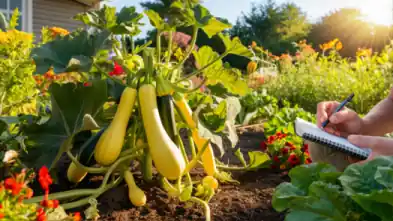
7. Companion Planting for Summer Squash
Companion planting involves strategically placing compatible plants near each other to enhance growth, deter pests, and improve overall garden health. Here are some beneficial companions for your summer squash:
- Nasturtiums: These colorful flowers attract pollinators and repel aphids and squash bugs.
- Marigolds: Their strong scent deters nematodes and other harmful insects.
- Borage: Attracts bees and provides shade to the soil, reducing weed growth.
- Radishes: Plant radishes alongside squash to deter cucumber beetles.
- Beans: Beans fix nitrogen in the soil, benefiting squash growth.
- Corn: Tall corn provides shade for squash leaves during hot summer days.
- Lettuce: Interplant lettuce to maximize space and provide a living mulch.
Remember to observe your garden and adjust companion planting based on your specific conditions. Happy gardening! 🌱🌿🌼

8. Pest Management for Summer Squash
Keeping pests at bay is essential for a successful summer squash harvest. Here are some natural solutions and preventive measures:
- Neem Oil: Neem oil is an effective organic insecticide. Dilute it according to instructions and spray it on your squash plants to deter pests like aphids, whiteflies, and squash bugs.
- Ladybugs: These beneficial insects feed on aphids and other harmful pests. Encourage ladybugs in your garden by planting flowers like dill, fennel, or marigolds.
- Companion Plants: As mentioned earlier, companion planting can help repel pests. Consider planting nasturtiums, marigolds, or borage near your summer squash.
- Regular Inspection: Check your plants regularly for signs of pests. Early detection allows you to take action promptly.
- Handpicking: If you spot squash bugs or cucumber beetles, remove them by hand. Dispose of them away from your garden.
- Row Covers: Use lightweight row covers to protect young plants from pests. Remove the covers once flowering begins to allow pollination.
Remember that a healthy garden ecosystem with diverse plants and beneficial insects contributes to pest control. Happy gardening! 🌿🐞🌼
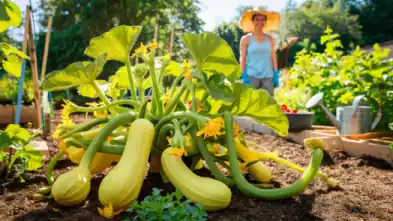
9. Watering and Drainage for Summer Squash
Proper watering and drainage are essential for healthy summer squash plants. Let’s explore both aspects:
- Watering Wisely:
- Consistent Moisture: Summer squash prefers evenly moist soil. Water deeply to encourage root growth, especially during flowering and fruiting.
- Avoid Overhead Watering: Water at the base of the plant to prevent fungal diseases. Drip irrigation or soaker hoses work well.
- Morning Watering: Water in the morning to allow foliage to dry during the day, reducing the risk of mildew.
- Drainage Considerations:
- Well-Draining Soil: Ensure your soil drains well. Raised beds or mounds can improve drainage.
- Elevated Planting: If your soil tends to retain water, consider planting in raised beds or on slight mounds.
- Avoid Waterlogged Soil: Excess water can lead to root rot. Monitor soil moisture and adjust watering accordingly.
Remember, finding the right balance between moisture and drainage is key to successful summer squash cultivation. Happy gardening! 🌱🌧️🌿
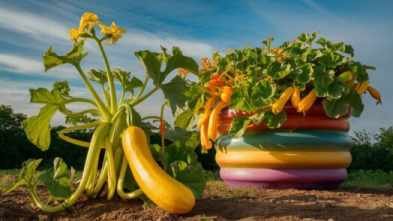
10. Weeding and Maintenance for Summer Squash
Maintaining a healthy summer squash garden involves proper weeding and pruning. Let’s dive into the details:
- Weeding:
- Regular Weeding: Keep your garden tidy by regularly removing weeds. Weeds compete with your summer squash plant for nutrients, water, and space.
- Mulching: Apply organic mulch (such as straw or wood chips) around the base of your squash plants. This suppresses weeds and conserves soil moisture.
- Pruning Tips:
- Remove Diseased Leaves: If you notice any yellowing or diseased leaves, prune them off. This helps prevent the spread of diseases.
- Deadheading Flowers: After squash flowers have wilted, remove them. This encourages more flower production and redirects energy to fruit development.
- Limit Lateral Growth: Trim excessive lateral branches to maintain an open canopy and improve air circulation.
Remember, a well-maintained garden leads to healthier summer squash plants and a bountiful harvest. Happy gardening! 🌱🌿🌼
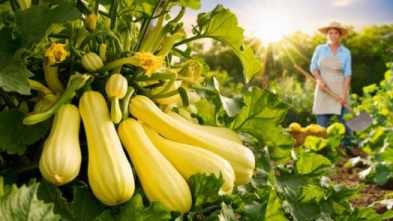
11. Harvesting Techniques for Summer Squash
Harvesting summer squash at the right time ensures peak flavor and maximum yield. Let’s explore the techniques:
- Peak Flavor:
- Harvest summer squash when they are young and tender. The skin should be glossy and easily pierced with a fingernail.
- Zucchini and other varieties are best when they reach about 6 to 8 inches in length. Crookneck squash can be slightly longer.
- Continuous Harvest:
- Summer squash plant are prolific producers. You can harvest them repeatedly throughout the growing season.
- Regularly check your plants and pick mature fruits to encourage new ones to develop.
Remember, harvesting promptly and regularly promotes healthy plant growth and a steady supply of delicious summer squash. Happy gardening! 🌱🌿🥒

12. Drainage, Fertilization, and Crop Rotation
Let’s cover essential aspects related to drainage, fertilization, and crop rotation for successful summer squash cultivation:
- Drainage Matters:
- Importance of Good Drainage: Proper drainage prevents waterlogged soil, which can lead to root rot. Ensure your garden beds have well-draining soil.
- Raised Beds or Mounds: If your soil tends to retain water, consider planting summer squash in raised beds or on slight mounds to improve drainage.
- Fertilize Right:
- Organic Fertilizers: Opt for organic options to nourish your summer squash plants. Some choices include:
- Compost: Rich in nutrients, compost improves soil structure and fertility.
- Well-Aged Manure: Provides essential nutrients and enhances soil health.
- Fish Emulsion: A liquid organic fertilizer high in nitrogen.
- Seaweed Extract: Contains trace minerals and growth-promoting compounds.
- Application: Apply fertilizers during planting and periodically throughout the growing season. Follow package instructions for proper dosage.
- Organic Fertilizers: Opt for organic options to nourish your summer squash plants. Some choices include:
- Crop Rotation:
- Why Rotate Crops?: Crop rotation prevents soil depletion and reduces pest and disease buildup.
- Rotate Families: Avoid planting summer squash in the same spot every year. Rotate it with other unrelated crops (e.g., tomatoes, beans, or leafy greens).
- Three-Year Cycle: Ideally, wait at least three years before planting summer squash in the same location again.
Remember, a well-drained soil, proper fertilization, and thoughtful crop rotation contribute to healthy summer squash plants and abundant harvests. Happy gardening! 🌱🌿🌼
13. Aesthetic Appeal of Summer Squash Plants
Creating an aesthetically pleasing garden involves more than just functionality—it’s about visual impact, colors, and textures. Let’s explore how to enhance the beauty of your summer squash plants:
- Visual Impact:
- Arrangement: Group summer squash plants together for a cohesive look. Consider planting them in rows or clusters.
- Trimming: Regularly trim any yellowing or dead leaves to maintain a neat appearance. Prune lateral branches to encourage upward growth.
- Colors and Textures:
- Foliage: Summer squash leaves vary in color—from vibrant green to silvery gray. Mix different varieties to create contrasting textures.
- Fruits: Choose a mix of zucchini (green or yellow), crookneck (with its unique shape), and patty pan (scalloped edges) for a colorful display.
- Companion Flowers: Plant colorful flowers nearby—marigolds, nasturtiums, or even sunflowers—to complement the squash foliage.
Remember, a well-designed garden not only provides fresh produce but also delights the eyes. Happy gardening! 🌱🌼🌿
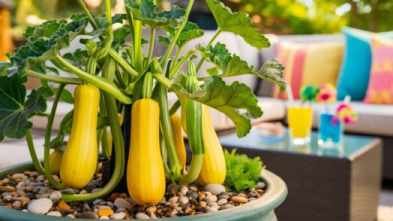
14. Sustainability Practices
Promoting sustainability in your summer squash garden is not only environmentally friendly but also beneficial for your plants. Let’s explore some practices:
- Chemical-Free Methods:
- Organic Pest Control: Avoid synthetic pesticides. Instead, use natural solutions like neem oil, companion planting, and beneficial insects.
- Compost: Create your own compost using kitchen scraps, yard waste, and plant trimmings. It enriches the soil and reduces waste.
- Beneficial Insects:
- Pollinators: Encourage bees, butterflies, and other pollinators. They play a crucial role in summer squash fruit development.
- Ladybugs and Lacewings: These insects help control aphids and other pests without harmful chemicals.
Remember, sustainable gardening practices benefit both your harvest and the environment. Happy gardening! 🌱🌿🐝
15. Disease Prevention for Summer Squash: Proper Spacing
Proper spacing is indeed crucial for preventing fungal issues in summer squash plants. Here’s why:
- Air Circulation: Adequate spacing allows air to circulate freely around the plants. Good airflow reduces humidity and minimizes the risk of fungal diseases, such as powdery mildew.
- Reduced Moisture Retention: When squash plants are too close together, their leaves can overlap, trapping moisture. Damp foliage becomes a breeding ground for fungi. Proper spacing ensures that leaves dry quickly after rain or irrigation.
Spacing Guidelines:
- Bush Varieties (Zucchini, Patty Pan):
- Leave about 2 to 3 feet between each plant.
- Space rows approximately 3 to 4 feet apart.
- Vining Varieties (Crookneck):
- Allow 3 to 4 feet between plants.
- Rows should be 4 to 5 feet apart.
Remember, maintaining the right spacing not only prevents diseases but also promotes healthy growth and higher yields. Happy gardening! 🌱🌿🍅
16. Adaptability of Summer Squash Plants to Changing Conditions
Summer squash plants are resilient, but it’s essential to prepare for weather fluctuations and extreme conditions. Here’s how:
- Weather Preparedness:
- Monitor Local Weather: Stay informed about upcoming weather changes. Adjust watering schedules based on rain forecasts.
- Covering: Use row covers or cloths during sudden temperature drops or frost warnings. These protective layers shield plants from cold.
- Extreme Conditions:
- Frost Protection: When frost is expected, cover your summer squash plants with blankets, burlap, or cardboard boxes overnight. Remove the covers during the day.
- Heatwaves: Provide shade during intense heat. Use shade cloth or position plants where they receive partial shade during scorching days.
Remember, proactive care ensures your summer squash plants adapt well to changing conditions. Happy gardening! 🌱🌿🌞
17. Container vs. Ground Planting
When deciding between container gardening and ground planting for summer squash, consider the following factors:
- Container Gardening:
- Advantages:
- Small Spaces: If you have limited garden space or a small balcony, containers are an excellent choice.
- Mobility: Containers allow you to move your squash plants to optimal sunlight or shelter as needed.
- Weed Control: Containers reduce weed growth.
- Considerations:
- Container Size: Choose large containers (at least 5 gallons) to accommodate summer squash roots.
- Quality Soil: Use well-draining, nutrient-rich potting mix.
- Watering: Containers may require more frequent watering.
- Support: Provide stakes or trellises for vining varieties.
- Advantages:
- Ground Planting:
- Advantages:
- Natural Environment: Summer squash thrives when planted directly in the ground.
- Root Space: Ground planting allows extensive root growth.
- Less Maintenance: Once established, ground-planted squash needs less attention.
- Considerations:
- Soil Preparation: Amend the soil with compost or organic matter.
- Spacing: Follow recommended spacing guidelines for each variety.
- Weeding: Regular weeding is essential.
- Drainage: Ensure proper drainage to prevent waterlogged soil.
- Advantages:
Choose the method that suits your space, resources, and gardening preferences. Happy growing! 🌱🌿🏡
A brief look back into the article
- Location and Space: Provide enough room for the summer squash plant to spread out.
- Sunlight Requirements: Aim for 6 to 8 hours of direct sunlight daily.
- Soil Conditions: Opt for well-draining, slightly acidic to neutral soil.
- Climate and Microclimates: Choose warm regions and consider microclimate variations.
- Planting Methods: Raised beds or containers work well; consider companion planting.
- Seasonal Considerations: Harvest young and tender fruits continuously.
- Sustainability Practices: Use organic methods and encourage beneficial insects.
- Adaptability: Be prepared for weather changes and protect against extreme conditions.
- Aesthetic Appeal: Arrange and trim for visual impact.
- Disease Prevention: Proper spacing helps prevent fungal issues.
- Container vs. Ground Planting: Choose based on space and preferences. Happy gardening! 🌱🌿🌞
Conclusion
Certainly! 🌱 Growing summer squash in your home garden requires attention to several key factors. First, assess the available space—these plants can spread out, so ensure they have enough room. Consider vertical gardening options like trellises or stakes to maximize space. Next, focus on sunlight requirements: summer squash thrives in full sun, so aim for 6 to 8 hours of direct sunlight daily. When it comes to soil, loamy soil with a slightly acidic to neutral pH (around 6.0 to 7.0) is ideal. Prepare the soil well by adding compost or aged manure. Be mindful of your local climate and microclimates; summer squash prefers warm temperatures and sheltered spots. Choose your planting method wisely—whether in containers, raised beds, or directly in the ground. Regularly harvest young, tender fruits to encourage continuous production. Practice sustainability by using organic methods, encouraging beneficial insects, and rotating crops. Finally, maintain aesthetics by arranging and trimming your plants. Happy gardening! 🌿🌞🍅
FAQs
Provide full sun (6-8 hours daily).
Use well-draining soil.
Water consistently.
Fertilize with compost or organic options.
Choose a sunny spot with enough space for spreading vines.
Harvest young (6-8 inches) for best flavor.
Use neem oil or companion plants.
Regularly inspect for pests.
Zucchini, crookneck, pattypan.
Full sun (6-8 hours).
